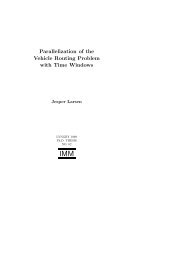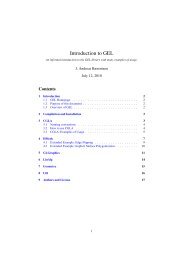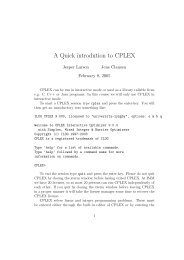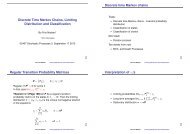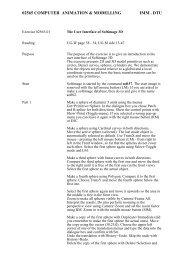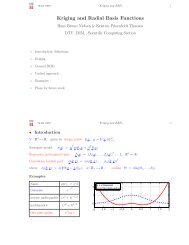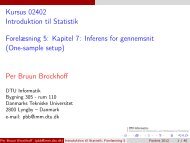Course 02286 - 2013, Week 12 Exercises on epistemic logics
Course 02286 - 2013, Week 12 Exercises on epistemic logics
Course 02286 - 2013, Week 12 Exercises on epistemic logics
You also want an ePaper? Increase the reach of your titles
YUMPU automatically turns print PDFs into web optimized ePapers that Google loves.
<str<strong>on</strong>g>Exercises</str<strong>on</strong>g> <strong>on</strong> the three cards scenarioFor the three cards scenario introduced in the lecture:1. C<strong>on</strong>struct an <strong>epistemic</strong> model M describing the scenario.Take as states all possible distributi<strong>on</strong>s of the cards.2. Formalize in <strong>epistemic</strong> logic the statements:2.1 Player 1 knows that everybody holds exactly <strong>on</strong>e of the cards.2.2 Player 1 knows the card (s)he is holding, but does not knowthe cards of the other two players.3. Determine whether the formulaP 1,A → K 1 (¬K 2 P 2,A ∧ ¬K 2 P 3,A )is true at every state of the <strong>epistemic</strong> model M.4. Update the model M after player 2 shows his card to 3 <strong>on</strong>ly.5. Using the updated model, argue that, after the acti<strong>on</strong> ofplayer 2, player 1 still does not know the card of player 3.
<str<strong>on</strong>g>Exercises</str<strong>on</strong>g> <strong>on</strong> the Three Muddy Children problemThree boys, A, B, and C, have played in the mud and some ofthem may have soiled their foreheads. Each of them can see theothers’ foreheads but not his own. The boys have perfect logicalreas<strong>on</strong>ing skills and are truthful in their announcements.1. C<strong>on</strong>struct the <strong>epistemic</strong> model describing the scenario.2. Using the propositi<strong>on</strong>s m X to mean “X has a muddyforehead”, for X ∈ {A, B, C}, describe with formulae of<strong>epistemic</strong> logic the following statements:2.1 “A knows that he has a muddy forehead or a clean foreheadbut does not know which <strong>on</strong>e.”2.2 “A knows whether the forehead of B is muddy or clean, andboth A and C know that B does not know whether B’sforehead is clean or muddy.”2.3 “If the forehead of C is clean, then that fact, and the fact thatC does not know it, are comm<strong>on</strong> knowledge am<strong>on</strong>g A and B.”
<str<strong>on</strong>g>Exercises</str<strong>on</strong>g> <strong>on</strong> the Three Muddy Children problem, c<strong>on</strong>tinued3. Determine the truth in the 3 muddy children <strong>epistemic</strong> modelof the <strong>epistemic</strong> formulae <strong>on</strong> the lecture slides (26, 27).4. Suppose hereafter that <strong>on</strong>ly A has a muddy forehead.The father comes and says“At least <strong>on</strong>e of you has a muddy forehead.”Update the model accordingly and use it to determinewhether each of the following is true.4.1 K A m A .4.2 K A ¬m B .4.3 K B ¬m B .4.4 K B K A m A .4.5 K A ¬K B ¬m B .4.6 C {A,B} ¬m C .4.7 D {A,B} (m A ∧ ¬m B ).




